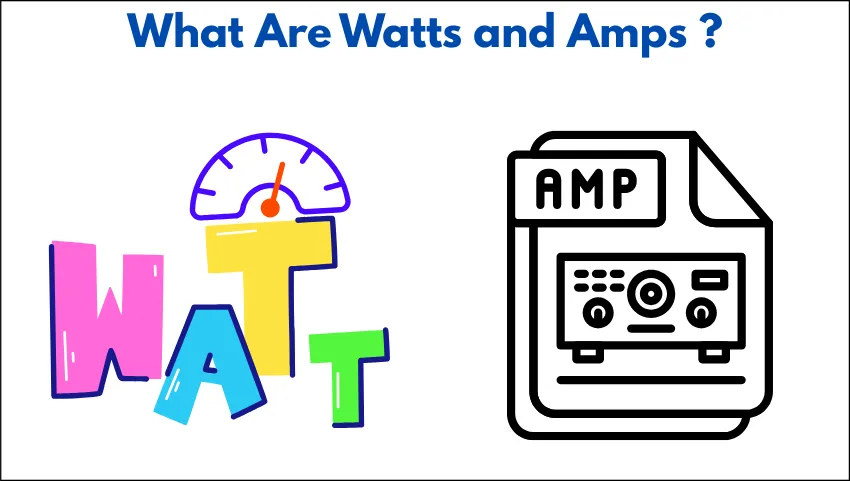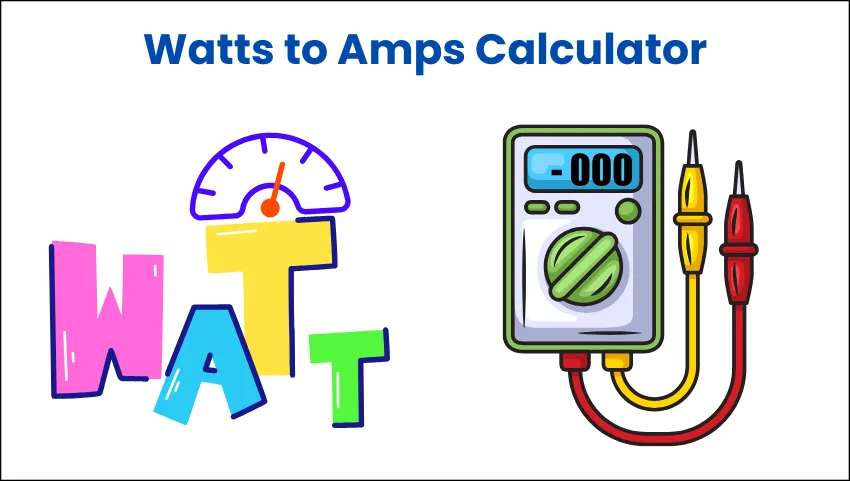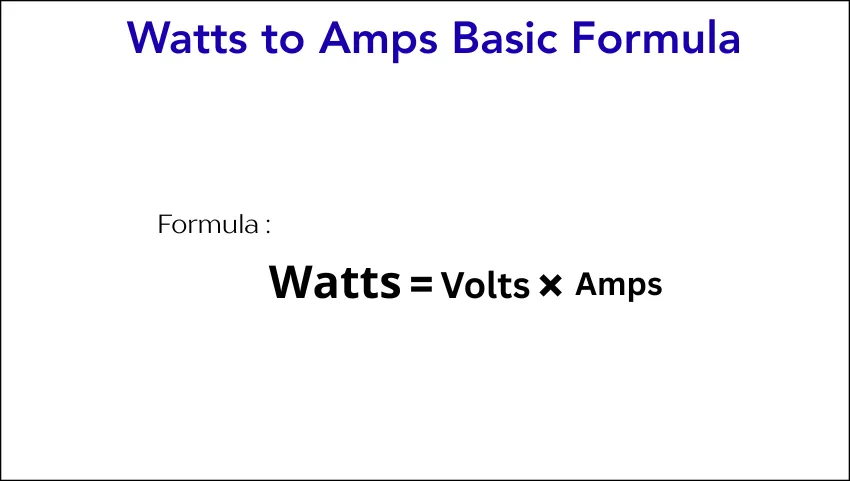Watts to Amps Calculator
Calculate Amps using the relationship between Amps, Volts and Watts. Simply fill in the values below and click 'Calculate'.
Watts to Amps Formula
Here are the basic equations to calculate the missing information:
Examples:
- 4160 Watts ÷ 208 Volts = 20 Amps
- 3600 Watts ÷ 240 Volts = 15 Amps
- 1200 Watts ÷ 120 Volts = 10 Amps
What are Amps, Volts and Watts?
Amps (Amperes)
Amps measure the flow of electricity as an electric current. Think of electric current as the flow of water through a hosepipe. The more water flowing through the hosepipe, the stronger the current is.
Volts (Voltage)
Volts are the measurement used to determine how much force is needed to cause the electric current to flow. In keeping with the water example, you could think of volts as the water pressure in the hosepipe, which makes the water flow.
Watts (Power)
Amps multiplied by Volts equals Watts, which is the measurement used to determine the amount of energy. The higher the wattage is, the more power and output from the appliance. In terms of the hosepipe example, this would refer to the amount of water being released.
AC and DC Power Systems
The labels 'AC' and 'DC' are used to describe the types of current flow in a circuit:
Direct Current (DC): The electric current flows only in one direction. An example would be a battery-powered device.
Alternating Current (AC): The electric current changes direction at 50 times per second (50 Hz) in the UK supply. AC is used to supply houses, buildings, and mains-connected appliances.
Electricity powers many things in our daily lives, from small gadgets to big appliances. When working with electrical devices, it’s important to understand how much current (amps) they draw based on their power consumption (watts). This is where a watts to amps calculator comes in handy.
What Are Watts and Amps?
To understand how to convert watts to amps, it’s important to first grasp what these terms represent.

- Watts (W): This is the unit of power or the rate of energy consumption or production. For electrical devices, it tells you how much energy they use in a given time. For example, a 60W light bulb uses 60 watts of power to light up.
- Amps (Amperes, A): This measures the electric current, which is the flow of electric charge through wires. Think of it like the amount of water flowing through a pipe; amps measure how much electricity flows.
- Volts (V): This is the electrical pressure or force that pushes the electric current through a circuit. Voltage is like the pressure of water in a hose.
These three quantities are connected by a fundamental formula:Watts=Volts×Amps
This formula means the power (watts) equals the voltage multiplied by the current (amps).
Why Is It Important to Convert Watts to Amps?
In practical electrical work, you often know the power rating (watts) of a device but need to find out the current (amps) it will draw from the power source.

Knowing the amps is crucial for several reasons:
- Safety: Electrical circuits must be designed to handle the current without overheating wires or tripping breakers.
- Selecting the right fuse or circuit breaker: These devices protect your wiring from overcurrent damage.
- Choosing compatible electrical components: Different appliances and devices connect to power sources with different voltages and current ratings.
- Planning power systems: For example, sizing batteries, generators, or solar panels involves calculating amps.
Hence, a watts to amps calculator helps to quickly determine the current, making electrical planning and troubleshooting easier and safer.
How to Convert Watts to Amps: The Basic Formula

Given the relation: Watts = Volts × Amps
To find amps (I), rearrange the formula: Amps = Watts/Volts.
This means that to find the electric current in amperes, you divide the power in watts by the voltage in volts.
Example:
If you have a 120-watt device running on a 120-volt power supply, the current drawn is:I =120 W/120 V=1 AI
This device draws 1 amp of current from the power source.
AC vs DC: Differences in Watts to Amps Calculation
Electrical power comes in two types:
- DC (Direct Current): Current flows in one direction (like batteries, solar panels).
- AC (Alternating Current): Current changes direction periodically (like household electricity).
DC Watts to Amps Formula
For DC, the formula is straightforward :Amps=Watts/Volts
Because voltage and current are steady, no additional adjustments are needed.
AC Watts to Amps Formula
For AC, things are a bit more complex because of the power factor (PF). This accounts for how effectively the power is used, especially with inductive loads (motors, transformers).
The formula becomes:Amps = WattsVolts×Power Factor
Power factor ranges from 0 to 1. A PF of 1 means all power is used effectively (resistive loads), while a lower PF means some energy is lost or reactive.
Example:
A 1200 W AC device on 120 V with a PF of 0.8 draws :I=1200120×0.8=12.5A
Knowing the power factor is important for accurate calculations.
Step-by-Step Guide to Using a Watts to Amps Calculator
If you want to calculate amps from watts, follow these simple steps:
Step 1: Identify the Type of Current
First, determine if your device uses:
- DC power (battery-operated, solar-powered devices)
- AC power (household appliances, industrial equipment)
This decides which formula to use.
Step 2: Find the Power Consumption in Watts
Look for the wattage rating on the device label or manual.
Step 3: Find the Voltage
Find the voltage the device operates at. Common voltages:
- Batteries: 12V, 24V, etc.
- Household AC: 120V (USA), 230V (Europe and India)
Step 4: Find the Power Factor (for AC)
If it’s AC and you want accuracy, find the power factor from the manual; otherwise, assume 1 for simple resistive devices.
Step 5: Enter Values into Calculator or Use Formula
- For DC: I=W/V
- For AC: I=WV×PF
Step 6: Interpret Results
The output is the current in amps your appliance or device will draw.
Using an Online Watts to Amps Calculator
If manual calculation sounds intimidating, use an online watts to amps calculator. These tools automate the math for you. Simply input the watts, voltage, and power factor (if needed), and get the amps instantly.
These tools are handy for electricians, engineers, students, and anyone working with electricity.
Practical Examples of Watts to Amps Conversion
Example 1: DC Circuit
A solar panel system uses a 240W panel at 24V DC:I=240W/24V=10A
The panel supplies 10 amps of current.
Example 2: AC Household Appliance
A toaster rated 1200W uses standard 120V supply with PF of 0.95:I=1200120×0.95≈10.53A
The toaster draws about 10.5 amps when operating.
Example 3: Industrial Motor
A motor rated 5000W operates at 400V three-phase AC with PF 0.9. For three-phase: I=3×V×PFPI=50001.732×400×0.9≈8.01AI=1.732×400×0.95000≈8.01A
The motor draws about 8 amps per phase.
Things to Remember When Using Watts to Amps Calculations
- Check Device Voltage: Always use the voltage the appliance is rated for.
- Consider Power Factor: Especially for AC motors or compressors, it affects current.
- Use Correct Units: Convert kilowatts (kW) to watts (multiply by 1000).
- Safety First: Never exceed the wire or circuit breaker current ratings.
- Consult Experts: For complex or high-power systems, get professional advice.
How Watts, Amps, and Volts Affect Your Electrical Setup
Understanding the relationship between these helps you:
- Choose the right wire gauge to prevent overheating.
- Avoid circuit overloads and potential fire hazards.
- Estimate energy consumption and electrical bills.
- Design efficient solar or battery systems.
Common Myths about Watts and Amps
- Myth: Higher watts always mean higher danger.
Fact: It depends on current and voltage; understanding amps is key to safety. - Myth: Watts and amps are the same.
Fact: Watts measure power; amps measure current flow.
Frequently Asked Questions
What is the watts to amps calculator?
A watts to amps calculator is a tool that helps you convert electrical power measured in watts into electric current measured in amps by using the voltage of the power supply. It simplifies the math needed to find how much current a device draws.
Can I convert watts to amps without knowing the voltage?
No. Voltage is essential to convert watts to amps accurately because current depends on both power and voltage.
What is the difference between watts and amps?
Watts measure the total power or energy usage, while amps measure the current or flow of electricity. Watts combine volts and amps in their calculation.
How does power factor affect watts to amps conversion?
Power factor reflects the efficiency of the electrical system, mainly in AC circuits. A lower power factor means more current is needed for the same power, so amps are calculated as watts divided by (volts × power factor).
Can I use a watts to amps calculator for solar panels or batteries?
Yes. For DC systems like solar panels or battery setups, the calculator helps determine the current by dividing the watts by the voltage.
Are watts and amps measured the same for all electrical devices?
No. Devices vary depending on AC or DC power, voltage ratings, and their power factor, which affects how amps are calculated from watts.
Conclusion
Converting watts to amps is straightforward once you understand the simple relationship between power, voltage, and current. }Amps=Volts×Power Factor Watts
you can quickly calculate the current drawn by any electrical device or system. Whether working on household wiring, designing solar setups, or just understanding your appliances, a watts to amps calculator is an essential tool.
